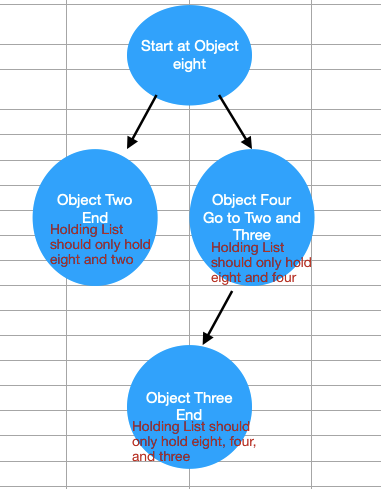如何在 Java 中处理分支计算?
我试图根据变量有多少个连接来找到最长的可能路径,而不需要重复连接。我想到的方法是创建一个列表,其中包含已经经过的所有点,但是当路径结束并且我需要检查新路径时,所有这些旧连接都保留在列表中。如何从初始点重新开始我的列表?
将其放入递归函数本身每次都会清除列表。有比使用列表更好的选择吗?
相关代码:
package testapp;
import java.io.BufferedReader;
import java.io.InputStreamReader;
import java.util.ArrayList;
import java.io.IOException;
import java.util.List;
class TestApp {
// Store list of objects we have already matched with
static List<NumberObject> holdingList = new ArrayList<NumberObject>();
//Test objects
static int[] array1 = {2,2};
static int[] array2 = {3,1};
static int[] array3 = {2,1};
static int[] array4 = {1,1};
static NumberObject eight = new NumberObject(array1, 8);
static NumberObject two = new NumberObject(array2, 2);
static NumberObject three = new NumberObject(array3, 3);
static NumberObject four = new NumberObject(array4, 4);
// Test objects ^^
public static int longestSequence(int[][] grid) {
// TODO: implement this function
// Code exists here not relevant to the problem
//Setting up a new numberList array for testing
NumberObject[] newNumberList = {eight, two, three, four};
NumberObject[] connections1 = {two, four};
NumberObject[] connections2 = {two, three};
//Adding connections
eight.connections = connections1;
four.connections = connections2;
for (NumberObject s: newNumberList){
recursive(s);
}
return 0;
}
理想情况下,图像显示我想要发生的事情。相反,所有旧的分支连接仍保持在 上holdingList。应该注意的是,路径可以分支到两个以上的其他对象。

 慕沐林林
慕沐林林1回答
-

宝慕林4294392
您可以将列表副本的实例作为参数传递给函数,而不是将列表存储在字段中。所以你的函数的签名recursive将如下所示:public static void recursive(NumberObject object, List<NumberObject> visited)为了隐藏此实现细节,我建议编写两个函数,其中第二个函数仅将空列表传递给另一个函数。但是,我会选择不同的方法,因为您的新列表会获取与树中的条目一样多的新列表。在以下实现中,每个“树端”只有一个列表。此外,就像前面的建议一样,这使您的班级保持无状态。static List<NumberObject> findLongestPath(NumberObject currentNode) { if (currentNode.getConnectedNodes().isEmpty()) { List<NumberObject> result = new ArrayList<>(); result.add(currentNode); return result; } List<NumberObject> longestPath = currentNode.getConnectedNodes().stream() .map(PathFinder::findLongestPath) .max(Comparator.comparing(List::size)) .get(); longestPath.add(currentNode); return longestPath; }
 随时随地看视频慕课网APP
随时随地看视频慕课网APP
相关分类

 Java
Java